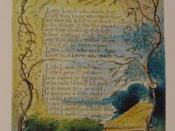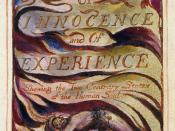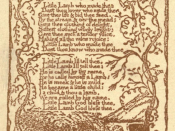Blake's "The Tyger" is a poem about the nature of creation, much as is his earlier poem from the Songs of Innocence, "The Lamb." However, this poem takes on the darker side of creation, when its benefits are less obvious than simple joys. Along the poem the doming feeling of both text and author is surprise. Blake's simplicity in language and construction contradicts the complexity of his ideas. This poem is meant to be interpreted in comparison and contrast to "The Lamb," showing the "two contrary states of the human soul" with respect to creation. The poem's speaker is never defined, and so may be more closely aligned with Blake himself than in his other poems. One interpretation could be that it is the author himself walking through the ancient forest and encountering the beast within himself, or within the material world. The poem reflects primarily the speaker's response to the tiger, rather than the tiger's response to the world.
It's important to remember that Blake lived in a time that had never heard of popular psychology as we understand it today. Blake's poetry "The Tiger" contains six four-line stanzas, and uses pairs of rhyming couplets to create a sense of rhythm and continuity. The notable exception occurs in lines 3 and 4 and 23 and 24, where "eye" is imperfectly paired, ironically enough, with "symmetry." The majority of lines in this lyric contain exactly seven syllables, alternating between stressed and unstressed syllables: This pattern has sometimes been identified as trochaic tetrameter -- four ("tetra") sets of trochees, or pairs of stressed and unstressed syllables -- even though the final trochee lacks the unstressed syllable. There are several exceptions to this rhythm, most notably lines 4, 20, and 24, which...



Another interpretation
This poem can be interpreted in another way; as the greatness of God creation. The poem compares and contrasts between the strong creation; the tiger, and the weaker creation; the lamb. It shows us the strength & power of the stronger creation. The poem also, emphasizes the might and power required in its creater.
I think that poem is very lovely and daring. The writer could describe one of its interpretations very clearly and logically.
1 out of 1 people found this comment useful.